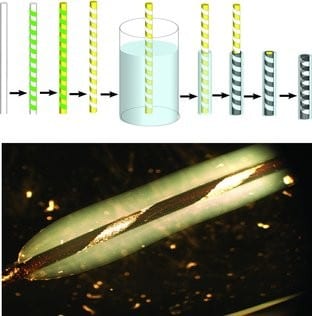Scientists have developed a novel nerve construct: artificial hybrid conducting polymer-hydrogel conduits have been used to repair peripheral nerve gaps.

Schematic illustration of the fabrication process and optical microscopy image of a PEDOT-agarose hybrid conduit.
We move, we touch, we hear, see, smell, or taste – our nerve cells are constantly transmitting stimulating signals to motor and sensory organs. Injuries that leave peripheral nerve lesions or nerve gaps, however, can cause a permanent loss of these abilities. Today’s clinical standard for peripheral nerve reconstruction, a very challenging task, is the use of autografts: nerve cells from other parts of the body are transplanted to close nerve gaps in the injured area.
Unfortunately, this method has several disadvantages: the number of donor cells that can be transplanted is limited, thus complex gaps cannot be bridged, and structural mismatch may occur. Additional problems are sensory deficits in the distribution of the donor nerve and painful dysesthesias that can follow sensory nerve harvest.
To overcome the limitations of autografts, scientists are searching for materials that can be applied in artificial conduits. Such conduits must fulfill several criteria: they should be biocompatible, mechanically stable during nerve regeneration, and permeable for nutrients and waste products.
Professor Abidian at Pennsylvania State University and his collaborators at the University of Michigan have recently reported a new artificial nerve construct in Advanced Healthcare Materials: for the first time they have combined a hydrogel (agarose) with a conducting polymer [poly(3,4-ethylenedioxythiophene), PEDOT] to form a hybrid conducting polymer-hydrogel conduit. Both materials have previously shown advantages to bridge nerve gaps: the hydrogel is biocompatible, permeable, and exhibits physical characteristics similar to those of soft tissue, but it suffers from a lack of mechanical strength, and swelling of the hydrogel can close the conduit cavities and block axonal (nerve fiber) regeneration.
PEDOT, a biocompatible but not biodegradable organic polymer, on the other hand, introduces mechanical stability and conductivity to the hydrogel, provides electrical, physical, and biochemical cues that stimulate in vitro neurite outgrowth, and can be functionalized with biomolecules, for example to develop biodegradable derivatives.
Professor Abidian and his co-workers have designed and developed novel templating methods to fabricate conductive hydrogel guidance channels. PEDOT is electrodeposited inside the lumen to create fully coated-PEDOT agarose conduits and partially coated-PEDOT agarose conduits. The scientists implanted their novel PEDOT-agarose conduits in 10 mm nerve gaps in rats and evaluated the progress twelve weeks after the operation. Although not as efficient as autografts, the hybrid conduits supported the neural regeneration and showed significantly improved functionality in comparison to plain hydrogel conduits.
This study paves the way for the design of a three-dimensional conductive hydrogel scaffold for accelerated, directional, and controlled axonal growth in the peripheral nervous system. Another potential application may be a biocompatible and seamless biotic–abiotic peripheral nerve interface for motor control and sensory feedback from neural prosthetic devices.

















